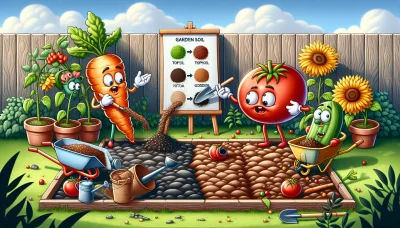Planting romaine lettuce Quiz
Test Your Knowledge
Question of
Introduction to Planting Romaine Lettuce
Planting romaine lettuce is a rewarding endeavor for both novice and seasoned gardeners alike. This leafy green is not only nutritious, but it also adds a crisp, fresh element to salads and sandwiches. Starting your romaine lettuce garden requires selecting a site with ample sunlight and well-draining soil. It's important to space the seeds or seedlings properly to ensure adequate air circulation and growth. Romaine lettuce prefers cooler temperatures, making it an ideal crop for spring and fall. Regular watering and occasional fertilization will help maintain its health and vigor. By incorporating romaine lettuce into your garden, you're not just growing a versatile vegetable; you're also contributing to a sustainable and healthy lifestyle.
Choosing the Right Soil for Romaine Lettuce
Romaine lettuce thrives in a soil that strikes the right balance between drainage and water retention. The ideal soil for growing romaine lettuce is loamy soil, which is a mix of sand, silt, and clay. This type of soil ensures that water drains effectively, yet retains enough moisture to keep the roots hydrated. The pH level of the soil is also crucial for the optimal growth of romaine lettuce. A slightly acidic to neutral pH, ranging from 6.0 to 7.0, provides the best conditions for nutrient uptake. Adjusting the soil pH and ensuring a well-balanced soil composition are key steps in preparing the garden for romaine lettuce.
Sowing Romaine Lettuce Seeds
To properly sow romaine lettuce seeds, start by selecting a well-draining soil area that receives plenty of sunlight. Prepare the soil by loosening it and adding compost if necessary to enrich it. Romaine lettuce seeds should be sown at a shallow depth of about 1/4 inch, as they require light to germinate effectively. Space the seeds approximately 1 inch apart in rows, and if sowing multiple rows, keep them about 12 to 18 inches apart to allow for adequate air circulation and growth. After sowing, gently water the soil, keeping it consistently moist but not waterlogged until germination, which typically occurs within 7 to 14 days. Thin the seedlings to about 8 to 12 inches apart once they have a few true leaves, to ensure they have enough space to mature. With proper care, your romaine lettuce will be ready to harvest in about 65 to 70 days from sowing.
Caring for Your Romaine Lettuce Plants
Romaine lettuce, with its crisp leaves and hearty flavor, is a favorite among gardeners and salad lovers alike. To ensure your romaine lettuce thrives, it's essential to provide it with the right care. Watering is crucial; aim to keep the soil consistently moist but not waterlogged, as romaine lettuce prefers a balance. It's often recommended to water your plants in the morning so the leaves can dry out over the day, reducing the risk of disease. Thinning the seedlings is another important step once they've sprouted, ensuring they're about 8 to 12 inches apart to allow for adequate growth and airflow between plants. Fertilization should be approached with care; a balanced, slow-release fertilizer applied at planting and midway through the growing season can promote healthy growth without overwhelming the plants. Remember, the key to a bountiful harvest lies in the balance of these care practices.
Pest and Disease Management for Romaine Lettuce
Romaine lettuce, a popular leafy vegetable, is susceptible to various pests and diseases that can significantly affect its growth and yield. Common pests include aphids, thrips, and slugs, which feed on the leaves, leading to damage and potential disease transmission. Diseases like downy mildew, powdery mildew, and botrytis rot also pose significant threats. Organic management strategies focus on prevention and natural remedies. Crop rotation, using disease-resistant varieties, and maintaining proper spacing to ensure good air circulation are foundational steps. Natural predators such as ladybugs can be introduced to control aphid populations, while neem oil and insecticidal soaps offer organic solutions for broader pest control. For disease management, applying organic fungicides and ensuring the foliage remains dry by watering at the base of the plants can be effective. Regular monitoring and prompt removal of affected plants are crucial to prevent the spread of pests and diseases.
Harvesting Romaine Lettuce
Romaine lettuce is best harvested in the cool hours of the morning, when its leaves are crisp, well-hydrated, and full of flavor. The ideal time to start harvesting romaine lettuce is when the leaves have formed a loose but well-defined head, and the plant is about 6 to 8 inches tall. To harvest, cut the plant at the base, leaving a small portion of the roots and the lower leaves behind. This method encourages regrowth for a potential second harvest. For the best taste and longevity, it's crucial to wash the lettuce immediately after harvesting and store it in a cool, humid environment. Avoid harvesting during the heat of the day, as this can cause the leaves to wilt and reduce their shelf life.
Romaine Lettuce Recipes and Uses
- Caesar Salad: Toss chopped romaine lettuce with Caesar dressing, croutons, and parmesan cheese for a classic salad.
- Grilled Romaine Hearts: Slice romaine hearts in half, brush with olive oil, and grill until charred for a smoky side dish.
- Romaine Lettuce Wraps: Use whole leaves as a low-carb wrap for chicken, beef, or shrimp, adding your favorite fillings like carrots, cucumbers, and a spicy sauce.
- Green Smoothie: Blend romaine lettuce with fruits like apple or banana, add a bit of ginger or mint, and enjoy a refreshing green smoothie.
- Taco Salad: Chop romaine lettuce and use it as a base for a taco salad, topped with ground meat, beans, cheese, salsa, and sour cream.
- Stir-Fry: Add chopped romaine lettuce at the end of cooking a vegetable stir-fry for a crunchy texture and a boost of green.
- Romaine and Fruit Salad: Combine romaine lettuce with slices of pear, apple, and walnuts, dressed with a light vinaigrette for a sweet and savory salad.
- Sandwich Topper: Use crisp romaine leaves as a crunchy, fresh addition to any sandwich or burger.
- Quick Pickled Romaine: Chop romaine lettuce and quick pickle it with vinegar, sugar, and spices for a tangy side dish.
- Romaine Soup: Simmer chopped romaine lettuce in chicken or vegetable broth with garlic and herbs for a simple, comforting soup.












